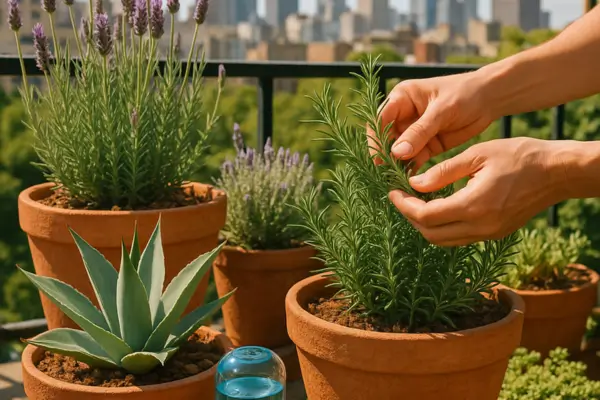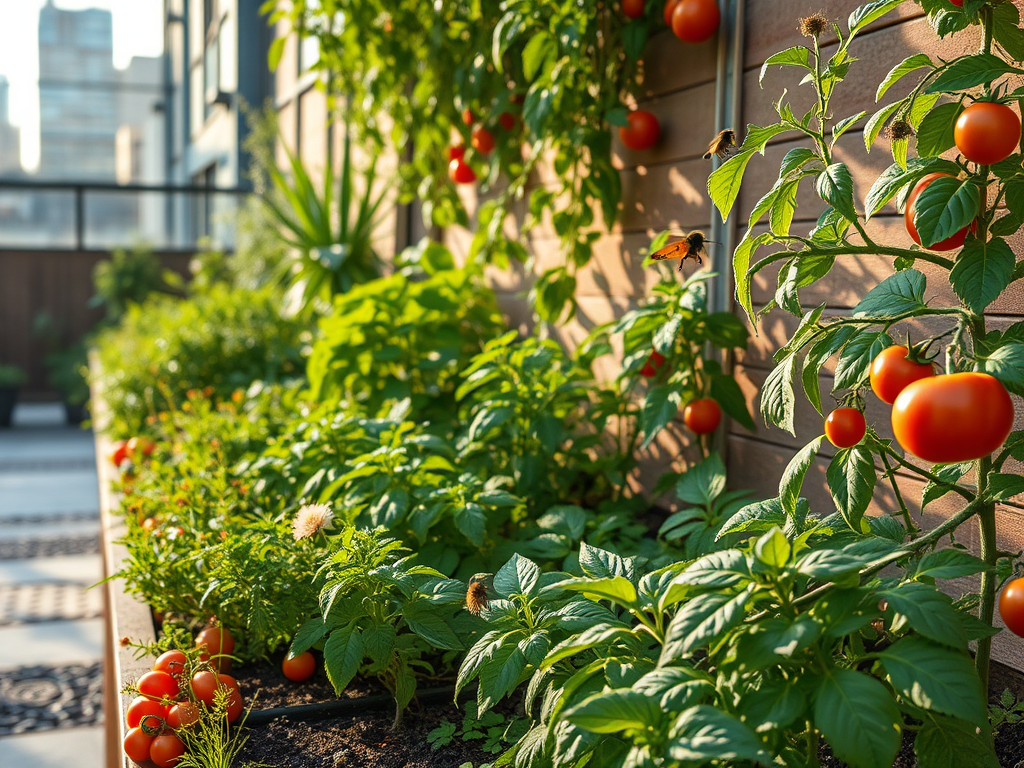Urban gardening is a powerful way to reconnect with nature, grow your own food, and greenify city spaces—but it comes with unique challenges. Limited space, polluted soils, and, most critically, water scarcity make traditional gardening difficult in urban environments. As climate change intensifies droughts and water restrictions become more common, city dwellers need resilient solutions to keep their gardens thriving.
That’s where drought-resistant plants shine. These hardy species are naturally adapted to survive—and even flourish—with minimal water, making them perfect for urban permaculture systems. By choosing plants like lavender, agave, or pomegranate, you can:
- Save water without sacrificing a lush, productive garden.
- Reduce maintenance (less watering, fewer pests).
- Support local ecosystems by attracting pollinators and improving soil health.
Urban permaculture takes this a step further, blending sustainable design with ecological principles. It’s not just about surviving dry conditions—it’s about creating self-sustaining, regenerative spaces that work with nature, not against it. Whether you’re working with a tiny balcony, a rooftop, or a community plot, drought-resistant plants are the key to a low-effort, high-reward urban oasis.
Ready to transform your space? Let’s explore the best plants and strategies to make it happen.
2. Why Choose Drought-Resistant Plants for Urban Permaculture?
Urban permaculture thrives when we work with nature rather than against it—and drought-resistant plants are a cornerstone of this approach. Here’s why they’re a game-changer for city growers:
1. Water Conservation in Cities
Fresh water is a precious—and often limited—resource in urban areas. Drought-resistant plants, like sedum, agave, and rosemary, have evolved to thrive on minimal moisture, reducing reliance on irrigation. By planting them, you help:
- Lower water bills (some species need watering just once a month!).
- Ease pressure on municipal supplies, especially during droughts.
- Prevent runoff waste, thanks to deep root systems that improve soil absorption.
2. Climate Resilience & Adaptability
As heatwaves and erratic rainfall become more common, traditional gardens struggle. Drought-resistant plants are natural survivors, built to handle:
- Scorching temperatures (e.g., lavender loves full sun).
- Poor soil quality (many thrive in rocky or sandy urban soils).
- Unpredictable weather, bouncing back faster after dry spells.
3. Reduced Maintenance for Busy Urban Dwellers
City life is fast-paced, and not everyone has time for daily garden care. These plants offer “plant it and forget it” benefits:
- Less watering: Once established, many need only rainfall.
- Fewer pests: Their tough leaves and aromatic oils (e.g., thyme, sage) deter insects.
- Minimal pruning: Slow-growing varieties like yucca stay tidy for years.
4. Support for Local Pollinators & Biodiversity
Drought-resistant doesn’t mean barren! Many of these plants are pollinator powerhouses:
- Bees and butterflies flock to lavender, salvia, and blanket flowers.
- Birds feast on drought-tolerant berries (e.g., elderberry, prickly pear).
- Soil microbes thrive around deep-rooted plants that improve soil structure.
By choosing these species, you’re not just saving water—you’re building a resilient, life-supporting ecosystem in the heart of the city.
Next up: The Top Drought-Resistant Plants for Your Urban Garden
3. Key Factors to Consider When Selecting Drought-Resistant Plants
Not all drought-tolerant plants are created equal—what thrives in a desert climate may drown in a humid city, and a sprawling shrub perfect for rural gardens could overwhelm a tiny balcony. To build a successful urban permaculture garden, consider these four essential factors before planting:
1. Climate & Hardiness Zones: Match Plants to Your Region
Drought-resistant doesn’t mean “one-size-fits-all.” A plant that survives Arizona summers might struggle in coastal fog. Here’s how to choose wisely:
- Check your USDA Hardiness Zone (or regional equivalent) to confirm which plants can survive your winters.
- Microclimates matter: Urban “heat islands” (e.g., concrete walls radiating warmth) can let you push zones slightly—but research first!
- Example: Agave thrives in hot, dry zones (9–11), while sedum tolerates colder climates (down to zone 3).
2. Soil Type & Drainage: Sandy vs. Clay Soils
Drought-resistant plants hate soggy roots. Improve your soil’s drainage to keep them healthy:
- Sandy soils: Drain too fast? Mix in compost to boost water retention.
- Clay soils: Hold too much water? Add grit or perlite to prevent root rot.
- Pro tip: Most drought-tolerant plants prefer lean, well-draining soil. Avoid over-fertilizing—it encourages thirsty new growth!
3. Sun Exposure: Full Sun vs. Partial Shade
Even sun-lovers can fry in reflected urban heat. Match plants to your light conditions:
- Full sun (6+ hours/day): Lavender, yucca, most succulents.
- Partial shade (3–6 hours/day): Red-flowering currant, some sage varieties.
- Watch for “sun traps”: Rooftops/south-facing walls may need shade cloth in peak summer.
4. Plant Maturity & Size: Fit Your Urban Space
A drought-resistant giant can outgrow its welcome fast. Plan for the future:
- Containers: Dwarf fruit trees (e.g., ‘Pixie’ pomegranate), small perennials (like thyme).
- Vertical spaces: Climbing drought-tolerant vines (e.g., trumpet creeper).
- Ground covers: Replace thirsty lawns with creeping thyme or sedum.
- Rule of thumb: Check the plant’s full-grown height/width—avoid species labeled “vigorous spreaders” in small plots.
Quick Checklist Before You Plant
✅ Zone-appropriate? Verify cold/heat tolerance.
✅ Soil ready? Test drainage (dig a hole, fill with water—it should drain within 2 hours).
✅ Light match? Track sun patterns for a week.
✅ Space-friendly? No planting 10-foot-wide shrubs on a fire escape!
Up next: The Best Drought-Resistant Plants for Urban Permaculture
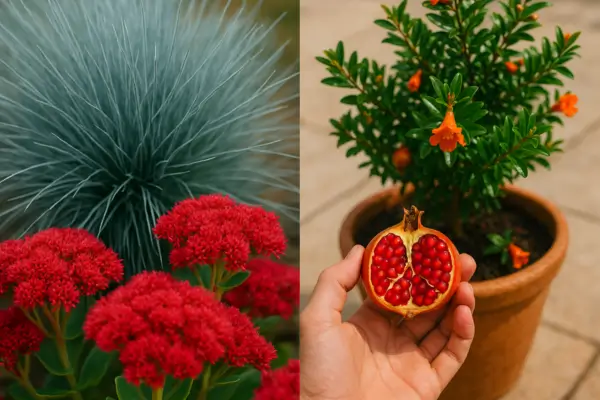
4. Top Drought-Resistant Plants for Urban Permaculture
Transform your urban space into a water-wise oasis with these resilient plants, carefully curated for permaculture designs. From edible herbs to fruit-bearing trees, these species thrive with minimal care while boosting biodiversity and productivity.
A. Herbs & Edibles
Perfect for container gardens, window boxes, or raised beds.
- Rosemary: Tough, aromatic, and loves hot, dry conditions. Use in cooking or as a pollinator magnet.
- Lavender: Fragrant, pest-resistant, and drought-proof. Great for borders or herbal crafts.
- Thyme: A low-growing ground cover that thrives in poor soil. Perfect between pavers or in rock gardens.
- Sage: Both culinary and ornamental varieties available. Tolerates neglect and poor soil.
- Oregano: Spreads easily, suppresses weeds, and adds flavor to dishes.
Urban Tip: Grow these in self-watering pots or vertical planters to save space.
B. Fruit Trees & Shrubs
Compact varieties ideal for small yards, patios, or large containers.
- Pomegranate (Punica granatum ‘Nana’): Dwarf varieties produce juicy fruit in tight spaces.
- Fig (Ficus carica): Drought-tolerant once established. Try ‘Little Miss Figgy’ for containers.
- Olive (Olea europaea): Symbol of resilience. Dwarf types like ‘Arbequina’ thrive in pots.
- Jujube (Ziziphus jujuba): Sweet, date-like fruit. Handles heat, drought, and poor soil.
Urban Tip: Espalier trees against walls to save space and create microclimates.
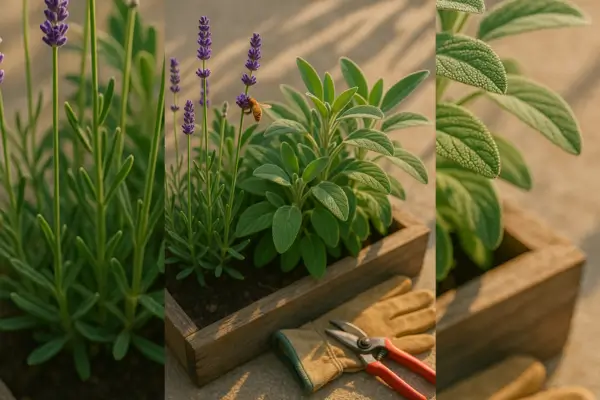
C. Perennials & Ground Covers
Replace thirsty lawns with these low-maintenance options.
- Sedum (Stonecrop): Succulent leaves store water. Ideal for green roofs or rock gardens.
- Agave: Architectural and nearly indestructible. Small varieties like Agave parryi fit containers.
- Yucca: Spiky and dramatic. Yucca filamentosa tolerates cold and drought.
- Blue Fescue: Ornamental grass with striking blue-gray foliage. Low-water alternative to traditional lawns.
Urban Tip: Pair sedum and agave in gravel gardens for a modern, low-water landscape.
D. Nitrogen-Fixers & Soil Improvers
Boost soil health naturally while conserving water.
- California Lilac (Ceanothus): Fixes nitrogen, attracts bees, and thrives in dry soils.
- Desert Willow (Chilopsis linearis): Not a true willow—beautiful blooms, minimal water needs.
- Birdsfoot Trefoil: A tough, flowering ground cover that enriches soil.
Urban Tip: Plant nitrogen-fixers near fruit trees to create a guild (permaculture’s companion planting system).
E. Climbing & Vertical Garden Plants
Maximize small spaces with drought-resistant vines.
- Passionflower (Passiflora): Exotic flowers and edible fruit. Drought-tolerant once established.
- Bougainvillea: Vibrant and nearly indestructible in warm climates.
- Trumpet Vine (Campsis radicans): Hummingbird favorite. Tolerates heat and poor soil.
Urban Tip: Train vines on trellises, railings, or pergolas to create shade and privacy.
Pro Tip: Mix and Match for Resilience
Combine plants from different categories to create a self-sustaining urban ecosystem. For example:
- Herbs + Fruit Trees: Plant thyme or oregano under a dwarf fig to suppress weeds.
- Ground Covers + Vines: Use sedum as a living mulch beneath passionflower.
What’s Next? How to Design Your Drought-Resistant Urban Garden
5. Maintenance Tips for Drought-Resistant Urban Gardens
Just because drought-tolerant plants are tough doesn’t mean they thrive on total neglect. Follow these low-effort, high-impact strategies to keep your urban permaculture garden flourishing with minimal water and fuss.
1. Watering: Less Is More (But Do It Right)
💧 Deep, Infrequent Watering
- Why? Encourages deep roots that resist drought.
- How? Water thoroughly (until soil is moist 6–12″ deep), then let the soil dry completely before watering again.
- Pro Tip: Use a drip irrigation system or soaker hose to target roots and reduce evaporation.
🚫 Avoid:
- Light sprinkles (promotes shallow roots).
- Watering in midday heat (up to 70% evaporates!).
🌱 New Plants vs. Established Plants:
- First 1–2 years: Water weekly to help roots establish.
- Mature plants: Many survive on rainfall alone (supplement only in extreme droughts).
2. Soil Prep: Build a Drought-Proof Foundation
🌵 Ideal Soil for Arid Conditions:
- Fast-draining mix: Sandy/gravelly soil amended with compost (for slight moisture retention).
- Avoid clay-heavy soils: Roots rot if water lingers. Improve drainage with perlite or pumice.
♻️ Mulch Like a Pro:
- Cover soil with 2–3″ of gravel, wood chips, or straw to:
- Reduce evaporation.
- Keep roots cool.
- Block weeds (which compete for water).
- Avoid mulch volcanoes around plant stems—they trap moisture and cause rot.
3. Pruning & Seasonal Care
✂️ Pruning Basics:
- Spring: Remove dead growth to stimulate new shoots.
- Summer: Lightly trim herbs (e.g., rosemary, sage) after flowering to maintain shape.
- Avoid heavy fall pruning—it triggers tender new growth that winter frost can kill.
❄️ Seasonal Adjustments:
- Winter: Protect young plants from frost with burlap or cloches (most drought-resistant plants hate wet + cold combo).
- Summer: Shade newly planted succulents during heatwaves (use 40% shade cloth).
🐝 Pollinator-Friendly Care:
- Leave some seed heads (e.g., lavender, sedum) through winter for birds and insects.

Final Tip: Observe and Adapt
Drought-resistant plants tell you what they need:
- Leaves curling? Probably thirsty.
- Dropping leaves? Often too wet (yes, really!).
Next Up: How to Harvest Rainwater for Your Urban Garden
6. Water-Saving Techniques for Urban Drought-Resistant Gardens
In cities, every drop counts. These practical, low-tech solutions will help you maximize water efficiency while keeping your drought-resistant garden thriving—even in tight spaces.
1. Rainwater Harvesting: Capture Free Water
💧 Small-Scale Systems for Urban Spaces:
- Barrels: Install a 50-gallon rain barrel under a downspout (check local regulations first).
- DIY Options: Repurpose food-grade containers or IBC totes with mosquito-proof screens.
- Pro Tip: Elevate barrels to create gravity-fed irrigation (just 1 ft of height = 0.5 PSI pressure!).
🌧️ Maximize Collection:
- Calculate potential: 1″ of rain on a 100 sq ft roof = ~60 gallons of water.
- Winter Prep: Drain barrels in freezing climates to avoid cracks.
2. Greywater Recycling: Safe Reuse of Household Water
🚿 What is Greywater? Gently used water from sinks, showers, or washing machines (avoid kitchen grease/oil!).
Urban-Friendly Systems:
- Laundry-to-Landscape: Direct washing machine outflow to mulch basins around trees.
- Bucket Method: Collect shower warm-up water for hand-watering.
⚠️ Safety Rules:
- Use plant-friendly soaps (no boron, salts, or bleach).
- Distribute greywater to deep-rooted plants (not leafy veggies).
3. Swales & Keyline Design: Micro-Earthworks
🌿 Mini Swales for Small Spaces:
- Dig a shallow, level trench (6–12″ deep) along contours to slow and spread rainwater.
- Fill with mulch to create an underground “sponge” for tree roots.
🏙️ Urban Adaptations:
- Container Swales: Use large pots with drainage holes at different levels to mimic a terrace.
- Keyline-Inspired Raised Beds: Shape beds to channel water toward drought-tolerant plants.
Quick-Start Action Plan
- This Weekend: Set up a rain barrel.
- Next Month: Install a laundry greywater diverter (check local codes).
- Next Season: Dig a mini swale around your fruit tree guild.
Coming Up: How to Build a Self-Watering Container
7. Common Mistakes to Avoid with Drought-Resistant Plants
Even the toughest plants can struggle if set up for failure. Here’s how to sidestep the top pitfalls of drought-resistant gardening—and keep your urban oasis thriving with minimal intervention.
1. Overwatering: The Silent Killer
💦 Signs You’re Loving Your Plants to Death:
- Yellowing or mushy leaves (especially in succulents like agave).
- Constantly damp soil (poke a finger in—it should dry out between waterings).
- Root rot smell (a foul odor = emergency repotting needed).
🚱 The Fix:
- Water only when soil is bone-dry 2–3″ deep.
- In pots, ensure drainage holes and use gritty soil mixes (cactus blend + perlite).
2. Poor Soil Prep: The Foundation Matters
⚠️ Classic Urban Soil Blunders:
- Compacted dirt: Roots can’t breathe or drink. Loosen with a fork before planting.
- No organic matter: Pure sand drains too fast; mix in 20% compost for moisture retention.
- Ignoring pH: Many drought-tolerant plants (e.g., lavender) crave alkaline soil. Test and amend with lime if needed.
🌱 Pro Tip: For container gardens, skip bagged “topsoil”—use a 3:1:1 mix of coarse sand, compost, and perlite.
3. Ignoring Microclimates
🏙️ Urban Heat Traps vs. Shady Corners:
- South-facing walls: Radiate heat—great for Mediterranean herbs (rosemary, thyme), but may fry delicate succulents.
- Alleyways/windy balconies: Speed up drying. Shield plants with a trellis or taller shrubs.
- Paved surfaces: Raise pots off hot concrete to prevent “root cookout.”
🔍 Do This: Map your space’s sun/wind patterns for a week before planting.
4. Accidentally Planting Invasive “Drought-Tolerant” Species
🚫 Plants That Take Over (and What to Grow Instead):
🌍 Why It Matters: Invasive plants escape gardens, choking out native ecosystems. Always check your local noxious weed list.
Bonus Mistake: “Set and Forget” Mindset
Drought-resistant ≠ zero care. Monthly Check-Ins:
- Prune dead growth to prevent disease.
- Refresh mulch to suppress weeds.
- Watch for pests (even dry gardens get spider mites in summer).
Next Up: How to Revive Overwatered Succulents
8. Maintenance Tips for Drought-Resistant Urban Gardens
Keeping a drought-resistant garden lush and healthy doesn’t mean hours of backbreaking work—in fact, these plants prefer a hands-off approach! Here’s your no-fuss guide to maintaining a thriving, water-wise urban oasis with minimal effort.
💧 Watering Wisdom: Less Is More
Drought-tolerant plants are built to survive dry spells, but they still need strategic hydration:
- Deep, infrequent drinks: Water only when the top 2–3 inches of soil are bone-dry, then soak thoroughly. This encourages deep root growth.
- Morning hours are magic: Water before 10 AM to reduce evaporation and prevent fungal issues.
- Listen to your plants:
- Wrinkled or shriveled leaves (e.g., agave, sedum) = thirsty.
- Yellowing or dropping leaves (common in lavender, rosemary) = too wet—stop watering!
Pro Tip: Use a moisture meter or the trusty “finger test” to avoid guesswork.
🌱 Soil & Mulch: The Dynamic Duo
Healthy soil = happy drought-resistant plants. Here’s how to keep it in top shape:
- Annual refresh: Each spring, top-dress with 1 inch of compost to replenish nutrients without over-fertilizing.
- Mulch like a pro: A 3-inch layer of gravel or wood chips will:
- Lock in moisture between waterings.
- Block weeds (which compete for water).
- Protect roots from extreme heat and cold.
Warning: Keep mulch a few inches away from plant stems to prevent rot.
✂️ Pruning & Seasonal Care: Timing Is Everything
These plants need occasional trims, but when matters:
- Spring: Remove dead growth and shape shrubs after flowering (e.g., sage, ceanothus).
- Summer: Lightly trim herbs (like thyme) to encourage bushiness.
- Fall: Avoid heavy pruning—new growth won’t survive winter frosts.
- Winter: Shield young plants with burlap or cloches if temperatures plummet.
Bonus: Leave seed heads (e.g., sedum, echinacea) through winter for birds and visual interest.
🐜 Pest Patrol: Spot Trouble Early
Even drought-resistant plants face pests—here’s how to handle them organically:
- Aphids? Blast them off with a hose or apply insecticidal soap.
- Spider mites? These thrive in dry heat. Spray leaves with neem oil weekly until gone.
- Scale insects? Scrape off with a fingernail or dab with rubbing alcohol.
Prevention Tip: Healthy, unstressed plants naturally resist pests—so stick to the “less is more” mantra!
🔥 The 5-Minute Monthly Check
Stay ahead of problems with this quick routine:
- Scan leaves for discoloration or pests.
- Test soil moisture—if it’s damp, skip watering.
- Clear debris (fallen leaves, dead stems) to prevent mold and rot.
Final Pro Tip: Drought-tolerant plants thrive on neglect. Overwatering, over-pruning, or over-fertilizing will harm them more than forgetting them entirely.
Next Up: How to Design a Self-Sustaining Drought-Resistant Garden
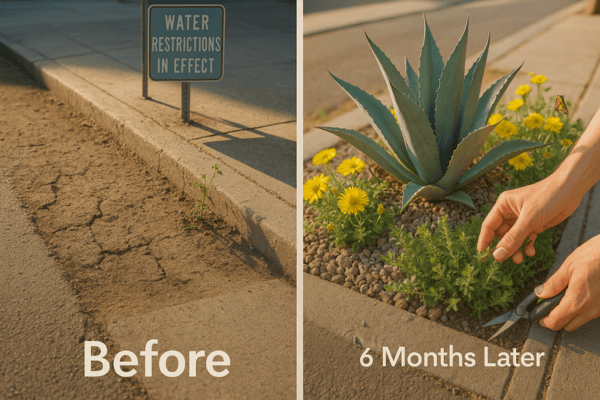
9. Success Stories: Urban Permaculture with Drought-Resistant Plants
Real gardens, real impact—these inspiring stories prove that even in the heart of the city, drought-resistant permaculture can transform barren spaces into thriving, sustainable oases.
1. The Balcony Food Forest (Seattle, WA)
Challenge: A north-facing apartment balcony with brutal summer droughts and strict water restrictions.
Solution:
- Drought-resistant edible guild: Dwarf pomegranate (centerpiece), surrounded by creeping thyme (ground cover), sage (pollinator magnet), and sedum (living mulch).
- Water-saving hacks: Self-watering containers + a small rain barrel hooked to the gutter.
Results:
✅ Year-round harvests (pomegranates, herbs) with 80% less water than traditional pots.
✅ Created a micro-habitat for bees and hummingbirds.
Quote from the Gardener:
*”I barely water, yet my plants are happier than ever. The thyme even survived a 3-week vacation!”*
2. The Parking Strip Paradise (Tucson, AZ)
Challenge: A barren, sun-baked parking strip in a water-scarce neighborhood.
Solution:
- Desert-adapted guild: Blue agave (focal point), desert marigolds (ground cover), and wolfberry shrubs (nitrogen-fixers).
- Earthworks: Mini swales to capture street runoff during rare rains.
Results:
✅ Eliminated irrigation after Year 1—plants thrive on rainfall alone.
✅ Reduced local temps by 7°F compared to neighboring paved strips.
Pro Tip: “We used recycled glass mulch for reflectivity—it looks stunning and keeps roots cool.”
3. The Rooftop Pollinator Hub (Chicago, IL)
Challenge: A windy, exposed rooftop with weight limits and no water access.
Solution:
- Lightweight dry garden: Sempervivums (green roof mats), lavender (pollinator buffet), and dwarf Russian sage.
- Greywater system: Diverted AC condensation to a hidden reservoir.
Results:
✅ Hosts 27+ pollinator species (documented by local biologists).
✅ Building owner saved $200/month on cooling costs thanks to the insulating plant layer.
4. The Community Garden Revival (Los Angeles, CA)
Challenge: A neglected lot with compacted soil and rampant vandalism.
Solution:
- Defensive planting: Spiky yucca and prickly pear along fences.
- Edible drought-resisters: Olive trees, rosemary hedges, and passionfruit vines on trellises.
Results:
✅ Zero water theft (thanks to unappealing-to-pick plants).
✅ Became a neighborhood education hub for dry gardening.
Key Takeaways from These Stories
- Start small: Even a single drought-resistant container plant makes a difference.
- Stack functions: Choose plants that feed you, wildlife, and the soil.
- Harvest every drop: Rain, greywater, or condensation—get creative!
Your Turn: Tag us with your #UrbanDryGarden success story—we might feature you next!
Next Up: DIY: Build Your Own Drought-Resistant Plant Guild
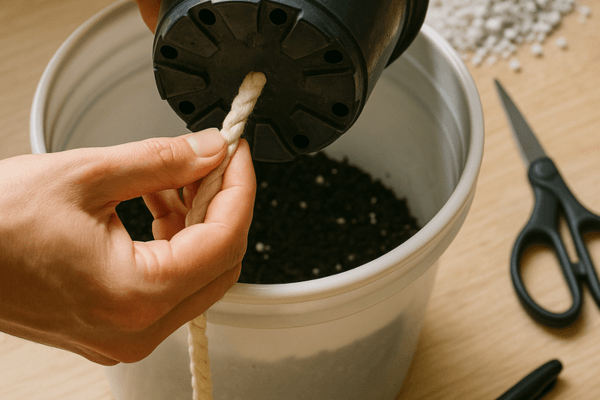
10. DIY Project: Create a Self-Watering Container Garden
Turn any small urban space into a low-maintenance, water-saving oasis with this easy self-watering planter project—perfect for busy gardeners or frequent travelers!
Why Self-Watering Containers?
- Save up to 50% water (no runoff or evaporation).
- Prevent over/under-watering—ideal for drought-resistant plants.
- Grow anywhere: Balconies, patios, fire escapes, or rooftops.
Step-by-Step Guide
Materials Needed (Budget-Friendly & Upcycled Options!)
- Container: 5-gallon bucket, storage tote, or wine barrel (avoid transparent containers—algae alert!).
- Wicking chamber: Plastic nursery pot, PVC pipe with holes, or repurposed water bottle.
- Wicking material: Cotton rope, strips of old T-shirts, or capillary matting.
- Soil mix: 3 parts cactus/succulent soil + 1 part perlite + 1 part compost.
- Tools: Drill, scissors, and a marker.
Eco-Hack: Use an old Styrofoam cooler as the container—it insulates roots from heat!
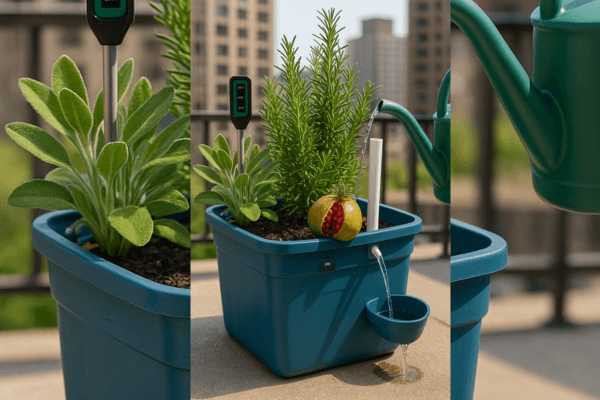
Assembly Instructions
- Prep the reservoir:
- Drill a 1/2″ overflow hole 2-3 inches from the bottom of your container.
- Insert the wicking chamber (e.g., upside-down nursery pot) in the center.
- Install the wick:
- Thread cotton rope through the chamber’s drainage holes, leaving one end in the reservoir and the other in the soil zone.
- Add soil & plant:
- Fill around the wicking chamber with soil mix.
- Plant drought-resistant species (see list below).
- Top with gravel mulch to reduce evaporation.
- Fill the reservoir:
- Pour water into the wicking chamber until it drains from the overflow hole.
- Refill only when the reservoir is dry (check weekly).
Best Plants for Self-Watering Containers
🌿 Herbs & Edibles
- Rosemary (loves dry roots!)
- Thyme (spreads beautifully)
- Dwarf pomegranate (surprisingly container-happy)
🌵 Succulents & Drought-Resisters
- Sedum (‘Autumn Joy’ is a champ)
- Agave (small varieties like ‘Blue Glow’)
- Lavender (bonus: pollinators adore it)
⚠️ Avoid: Cacti or plants that hate moist roots (e.g., sagebrush).
Pro Tips for Success
- First 2 weeks: Top-water to help roots establish.
- Winter care: Drain reservoirs to prevent freezing.
- Fertilize lightly: Use compost tea 1-2x/year—drought plants hate heavy feeding!
Upcycle Idea: Convert an old plastic storage bin into a self-watering veggie patch for cherry tomatoes + basil!
Before You Go…
📸 Share Your Build! Tag #UrbanDryGarden—we’ll feature the most creative upcycles!
Next Up: How to Pair Your Self-Watering Planter with a Rain Barrel
Grow Greener, Even in the City
Drought-resistant plants aren’t just survivors—they’re thrivers, transforming urban spaces into lush, resilient ecosystems with minimal water and effort. From balconies to rooftops, these hardy species prove that sustainability and beauty can go hand-in-hand.
Why It Works
✅ Saves water in drought-prone cities.
✅ Reduces maintenance for busy urbanites.
✅ Supports biodiversity with pollinator-friendly blooms.
✅ Future-proofs your garden against climate extremes.
Your Next Steps
- Start small: Try one drought-resistant herb (like thyme) in a self-watering pot.
- Observe and adapt: Notice which plants thrive in your microclimate.
- Stack functions: Choose plants that feed you, wildlife, and the soil (e.g., nitrogen-fixing ceanothus).
🌿 Share Your Journey!
We’d love to see your water-wise oasis—tag #UrbanDryGarden or drop a photo in the comments. Your experiment might inspire someone else’s permaculture revolution!
P.S. Every drop counts—your tiny garden patch is part of a global water-saving movement. Keep growing!

